

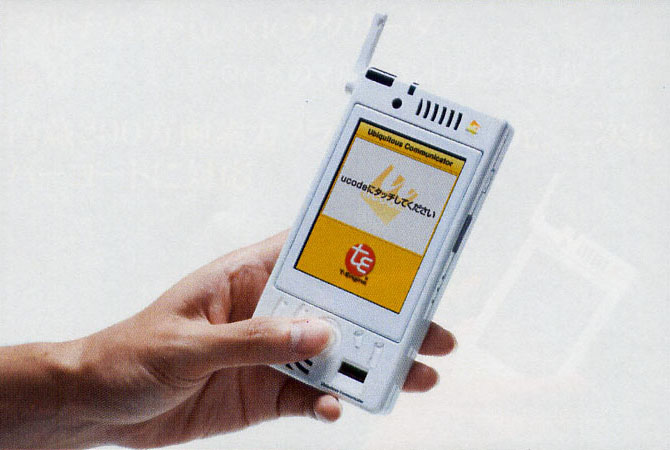
Prof. Ken Sakamura, leader of the T-Engine and Ubiquitous ID projects, unveiled a new version of the Ubiquitous Communicator on September 15 at press conference held at YRP Ubiquitous Networking Laboratory in Gotanda, Tokyo. The new Ubiquitous Communicator is the sixth developed by the laboratory over approximately the last two years, and it is different from previous models in that it has more functionality and is based on specially developed a ASIC chip for accelerating graphics. This chip allows for the new Ubiquitous Communicator to be lighter and more compact, and also to sport a higher resolution color liquid crystal display. Another unique feature is a dual band non-contact interface for reading RFIDs on the back of the Ubiquitous Communicator. It can read IC tags using either of the two frequencies specified by the Ubiquitous ID Forum, i.e, 13.56 megahertz and 2.45 gigahertz. Prof. Sakamura said that these advancements will soon enable companies to start producing Ubiquitous Communicators for sale in Japan.
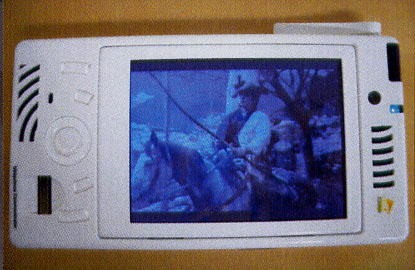 |
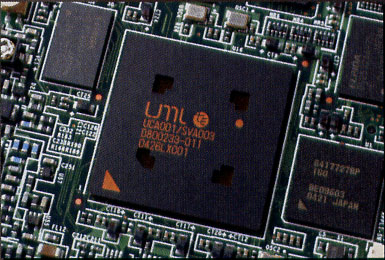 |
| The new Ubiquitous Communicator can replay MPEG video at 30 frames per second in VGA, or 480 x 640 dot, resolution. | A specially developed ASIC chip accelerates JPEG/MPEG encoding and decoding, plus capturing, rotating, and scaling. |
Although the Ubiquitous Communicator may seem like a futuristic, advanced technology to younger people, it is actually the realization of the "communication machine" concept proposed 20 years ago in the mid 1980s by the TRON Project, from which the T-Engine and Ubiquitous ID projects are an outgrowth. Like the communication machine in the 1980s, the Ubiquitous Communicator is designed to allow users to communicate with themselves, people, and things, with the concept of things including the living and work environments that surround people. The only things that are new are low-cost RFID tags based on "ucode" and the eTRON architecture, which is the security architecture that comes as standard equipment on all T-Engine based devices, of which the Ubiquitous Communicator is one. The camera functions and wireless LAN/Bluetooth functions of the Ubiquitous Communicator also didn't exist in the 1980s, but things like this were envisioned in TRON PR materials at the time. Here is the hardware specification for the new Ubiquitous Communicator.
| CPU | 32-bit RISC chip |
| Display | VGA (480 x 640 pixel) color LCD screen |
| Built-in communications functions | Wireless LAN (IEEE802.11b), Bluetooth |
| Non-contact interface | 13.56 MHz plus 2.45 GHz dual antenna built in |
| Card interface | SD x 1, miniSD x 1, SIM (eTRON) x1 |
| Camera | 300,000 pixel pixel x 1, 2 million pixel x 1 |
| Infrared interface | Input x 1, output x 1 |
| Biometrics | Fingerprint authentication unit x 1 |
| Sound | Stereo speaker, microphone, headphone output |
| Specialized ASIC | Motion and still picture accelerator, video capture, encryption processing (can handle 30 frames per second at 480 x 640 resolution) |
| External interfaces | Cradle connection connector (serial interface, USB, other) |
| Dimensions | 144 mm x 76 mm x 15 mm |
| Weight | 196 grams |
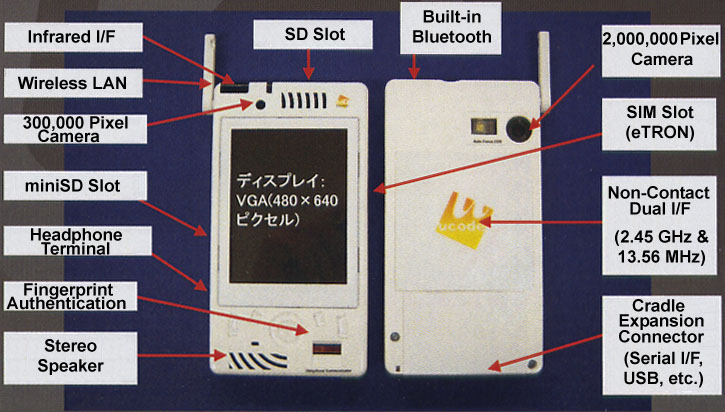
Since it is based on the original communication machine concept, the new Ubiquitous Communicator is, of course, a multilingual device, and this was demonstrated at the press conference. In fact, Prof. Sakamura said that his laboratory has already started experiments with sister organizations in China and Korea using Ubiquitous ID technologies. Those sister organizations, no doubt, have been keeping track of experiments taking place in Japan under the sponsorship of various Japanese ministries. Farm produce has already been tracked using uIDs in the Kanto area around Tokyo under the sponsorship of the Ministry of Agriculture, Forestry and Fisheries; and a section of the port city of Kobe, which is in the Kansai area near Osaka, will be playing host to Autonomous Movement Support Project trials under the sponsorship of the Ministry of Land, Infrastructure, and Transport. In addition, the pharmaceutical and freight shipping industries have also started to conduct verification trials of their own using Ubiquitous ID technologies.
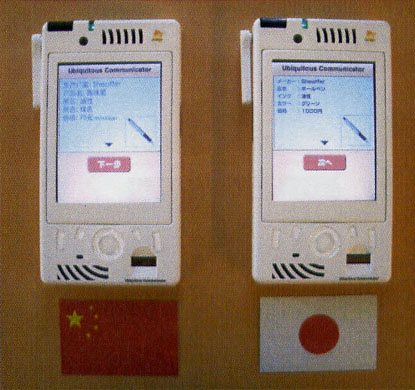 |
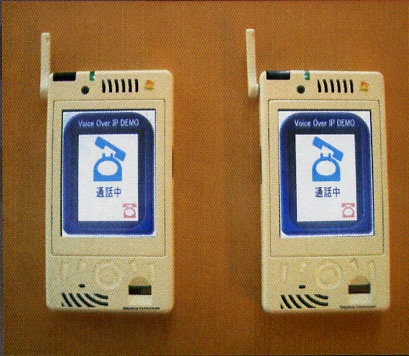 |
| The new version of the Ubiquitous Communicator can display the scripts of other Asian countries, such as China and Korea. | The wave of the future is Voice over IP, and the new Ubiquitous Communicator can handle it with its Wireless LAN function. |
During the question and answer session at the press conference, Prof. Sakamura was asked the most obvious question, i.e., exactly how much the new Ubiquitous Communicator would cost when it is commercialized and sold to the general public. Although that depends a lot on what optional features a manufacturer decides to include, Prof. Sakamura estimated, based on its rich functionality, that it would initially be in the 300,000 yen range, although that would probably drop to the price of a high-end digital camera when lots of people start using it. He said he believed that use of the UC would probably suddenly explode just as the Internet did several years ago. In order to get to that stage, he said, a lot of things would be required, such as the widespread employment of uID tags, the construction of ubiquitous computing networks, and the provision of servers for running the services within the ubiquitous computing networks. He also said that the new UC will be demonstrated at TRON SHOW 2005, which will be held December 7-9 in Tokyo.
During the press conference, Prof. Sakamura noted that the number of members on the T-Engine Forum had risen to 452, which is almost three times as high as the number of companies and organizations that joined the TRON Association back in the late 1980s. He also stated that next year, a Ubiquitous ID center will be opened in the U.S. As to supply chain management and the EPCglobal project, Prof. Sakamura replied that he has great confidence that he and his team can handle supply chain management, and that he would like to help the EPCglobal project, not fight with it. However, since EPCglobal is using on proprietary technologies, which seem to be aimed mainly at supply chain management for the vast Wal-Mart retail chain and its suppliers, no help can be offered until those technologies become open international standards. Conversely, the Ubiquitous ID project has even developed an open standard for intelligent triangulation points that can be used in cities to help people find out what their exact location is.
The Autonomous Movement Support Project verification trials, which will be held in the port city of Kobe with the cooperation of the Ministry of Land, Infrastructure, and Transport from October through December of this year, were commenced in an opening ceremony that was held in Kobe on September 30. The verification trials are aimed at paving the way to the realization of what the project's organizers call a "universal society," that is, a society in which anyone can receive via ubiquitous networks the information he/she needs to freely move about on their own without the help of others. They will take place at two locations in the city: (1) the underground passageway/shopping mall of Sanchika Town, and (2) the intersection in front of the Bank of Japan branch in Kyomachisuji. In both of these locations, the latest version of the Ubiquitous Communicator (see above) will be employed along with Ubiquitous IDs for the first time in a large-scale demonstration in public places to support the movement of people, both handicapped and able-bodied.
In the verification trials in Kobe, infrared markers, wireless markers, and radio frequency identification (RFID) tags will all be used to test the multiple means of communication that the new Ubiquitous Communicator is capable of. These will include intelligent triangulation points that were developed in cooperation with the Ministry of Land, Infrastructure, and Transport. The goal of the trials is to verify in public places the following: (1) that optimized information can be provided to users based on user profiles (including voice guidance for the visually disabled, and barrier free information for the wheelchair bound), (2) that this information can be provided in multiple languages (Chinese, English, Japanese, and Korean), and (3) that an SOS signaling function can be used to help people in emergency situations. In addition, the shops in the underground passageway/shopping mall of Sanchika Town are cooperating with the project by providing on-line shopping data that can be accessed from the Ubiquitous Communicator in accordance with the wishes of the user.
Personal Media Corporation announced on September 30 that it would begin shipping from the middle of October a new µT-Engine development kit that includes the first µT-Engine development board equipped with a microprocessor based on the popular ARM microprocessor architecture. (Click here for a picture of the new µT-Engine development board.) The new "µT-Engine/ARM7-LH79532 Development Kit," which is the third µT-Engine development kit to be commercialized by Personal Media to date, will be marketed at a price of 155,400 yen (tax included). It is based on a Sharp Corporation low power consumption LH79532 microprocessor, which employs an ARM7TDMI core running at 50 megahertz. This microprocessor is currently widely used in various consumer appliances, such as personal digital assistants, electronic dictionaries, electronic books, handheld data terminals, and electronic toys. The hardware and software specification of the µT-Engine/ARM7-LH79532 Development Kit are as follows:
|
|
|
| CPU | Sharp LH79532 (ARM7TDMI core, 50 MHz) |
| Flash memory | 8 Megabytes |
| SDRAM | 16 Megabytes |
| Input interfaces | Compact Flash (CF), serial, eTRON chip I/F, MMC card, expansion bus I/F, liquid crystal panel I/F, touch panel I/F |
| Other functions | Real-time clock (RTC) |
| Power source | AC adapter |
| External dimensions |
|
|
|
|
| T-Monitor | Standard T-Engine monitor |
| T-Kernel | T-Kernel/OS (Operating System), T-Kernel/SM (System Manager), T-Kernel/DS (Debugger Support) |
| PC card manager | Bus driver |
| Device drivers | RTC, console (serial), screen (LCD), system disk (CF) with source programs included |
| Sample programs | Source programs included |